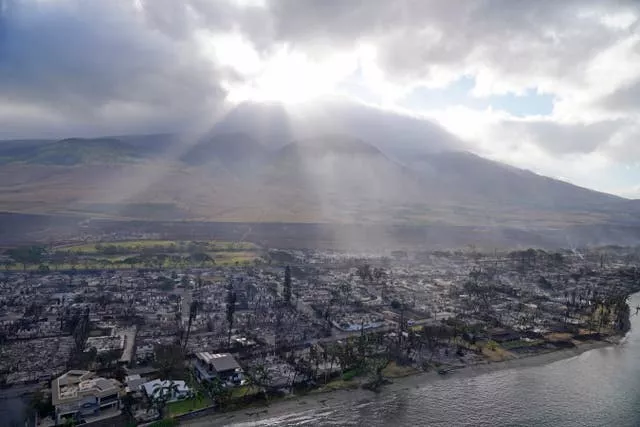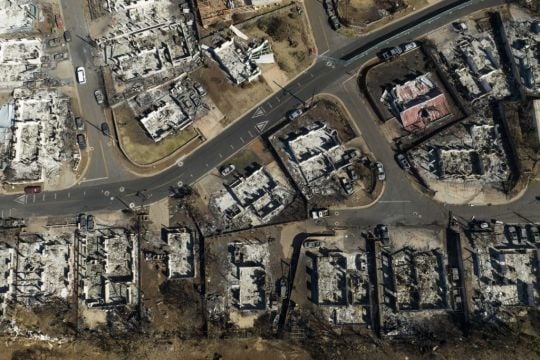Investigators reviewing the emergency response to last year’s devastating wildfire on Maui said in a report released on Friday that they found “no evidence” Hawaii officials made preparations for it, despite days of warnings that critical fire weather was about to arrive.
That lack of planning hindered efforts to evacuate the historic town of Lahaina before it burned in a conflagration that claimed 102 lives, the report said.
A weather forecaster with the National Weather Service went above and beyond normal procedures by emailing fire managers on August 4 2023 to give them “unprecedented advance warning” of the danger that would develop on August 8, including extreme winds as a hurricane passed far to the south, according to the report released by the state attorney general.

The email stressed the unusual certainty of forecast models and “significant concern” on the part of forecasters.
But in the ensuing four days, the report found, there is no evidence that key agencies — the Hawaii Emergency Management Agency, Maui Fire Department (MFD), Maui Police and others — developed plans for dealing with severe wildfire risk, such as by having extra staff on duty, stationing emergency vehicles or supplies in high-risk areas or plotting possible evacuations.
“The strongly worded nature of the email, had it been communicated to fire managers in other states with better-developed severity preparedness strategies, could have gained attention and prompted discussion and operational planning,” the report said. “It was a call for State of Hawaii fire managers to prepare for the impending extreme weather.”
The heroic efforts of firefighters and police — who frequently risked their lives, sometimes sprinting door-to-door to warn residents to leave or piling evacuees into their cars to drive them to safety — were undercut by a lack of planning as the deadliest US wildfire in a century destroyed thousands of buildings and caused billions in damages.
Maui fire commanders discussed the forecast but “no evidence of pre-event preparedness plans by the MFD were produced,” the report said.
The police and fire departments never established a unified incident command post and as a result, it was more difficult to know who was responding to what or where evacuation routes were blocked by downed trees or power lines.
The departments share a mobile command vehicle but the county did not provide evidence that it was used that day, the report said, adding that some emergency vehicles didn’t have equipment for clearing roadblocks like fallen trees or locked gates on private roads.
With multiple fires burning on Maui before the devastating blaze erupted in the afternoon, police focused on routine duties like traffic control rather than preparing for an evacuation, the report said.

Responders lacked an incident action plan, which meant trouble figuring out where to direct resources. The police and fire departments operated separately, hindering communication as the winds toppled utility poles, cutting power and cell service.
Maui firefighters and the Department of Land and Natural Resources use private contractors to help them fight fires with water tankers, excavators and other equipment but those contractors mostly relied on mobile phones and weren’t trained to use portable radios, therefore they had to communicate with firefighters in person due to the lack of cell service, which reduced their effectiveness.
Firefighters had to flag down water tankers to ask them to fight fires. Some hydrants failed as water pressure fell.
Maui Fire Department policy requires relief engines — those that back up the front-line fleet during major events — to always be ready to respond to an emergency. However, some lacked essentials such as breathing equipment and portable radios, the report said. Personnel at fire stations spent valuable time locating and loading items such as hoses, nozzles and hand tools.
And despite the warnings from forecasters, the heads of the county emergency management agency and the Maui Fire Department were both off-island that day, attending conferences in Honolulu. The report said no one appeared to be in charge of strategic resource allocation.
Some of the challenges facing officials and residents were particular to Hawaii and Maui: narrow roads clogged with parked cars, and small, inconsistently named dirt roads — “Oil Road”, “Old Road” “Old Oil Road” — often blocked by gates.
Many older, wooden homes were designed to resist heat and humidity, not wildfire. They were often separated by less than six feet and residents frequently left windows open, making it easier for the fire to spread.
Many homes had additions to accommodate extended family, a common practice in Hawaii, which has some of the most expensive housing in the nation.
Some people died in their cars. Others leaped into the ocean to escape the flames.
The 518-page report, conducted for the Hawaii attorney general’s office by the Fire Safety Research Institute, is the second part of a three-part attempt by officials to understand the tragedy and how best to avoid such disasters in the future.

The review determined that the lack of planning fit a long pattern of apathy to wildfire risk in Hawaii, where tsunamis and hurricanes are considered more pressing dangers, and it was among many factors that set the stage for the catastrophe.
The report suggested that fire managers might have focused on the first sentence of the National Weather Service’s email, which noted Hurricane Dora was expected to pass south of the state, rather than make landfall, and thus assumed Hawaii was safe.
Nationally, the report noted, people think of Hawaii as a tropical vacation destination, not fire-prone. Even among residents, it may be difficult to get excited about wildfire risk when “red-flag weather” — hot, dry and windy — isn’t much different from a typical summer day.
“While much of Hawai’i, including Maui, has a relatively high risk of wildfire occurrence, it appears the perception of this risk — at the local, state, and national levels — is not always aligned with the actual, growing threat wildfires pose to the population and built environment,” the report said. “This gap between risk perception and reality seems to have contributed to a relative underinvestment in wildfire prevention, preparedness and response capacity over the years.”
Even though a 2018 wildfire in West Maui near Lahaina burned 2,000 acres (810 hectares), destroyed 21 structures and forced 600 people into shelters, the Maui Police Department’s “Natural and Man-Made Disaster Plan” didn’t include wildfires.
The Maui Fire Department has policies for responding to hurricanes but the department had no such policies for high fire danger, the report said.

And even though Maui County passed legislation in 2022 giving the fire department the authority to require property owners to clear vegetation, such as the dry invasive grasses that helped fuel the August 8 fire, under penalty of a fine, the county “has not produced any evidence that the MFD has enforced these amendments in the Lahaina area,” the report said.
The report further called for better vegetation management and fire breaks. It also recommended providing alternate means of firefighting water supply for extreme events, including portable pumps to draw from pools, ponds and even the ocean.
The report urged Maui police, firefighters, the state land department and Maui emergency managers to work on their procedures for joint incident management: “These procedures are very common in other jurisdictions in the United States.”
The Maui Police Department should develop safe evacuation procedures, and the fire department should establish operating procedures for bad fire weather, it said. That would include preparing and pre-positioning equipment and personnel in high-risk areas, ensuring clear and open lines of communication for rapid deployment of resources, and better preparing the public for possible evacuations.







